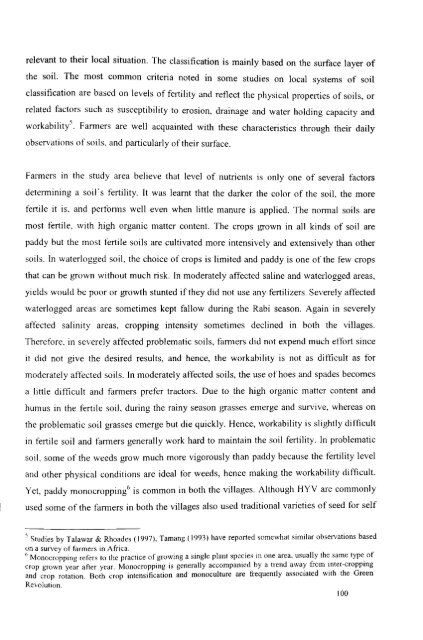Water Users Association and Irrigation Management - Institute for ...
Water Users Association and Irrigation Management - Institute for ...
Water Users Association and Irrigation Management - Institute for ...
You also want an ePaper? Increase the reach of your titles
YUMPU automatically turns print PDFs into web optimized ePapers that Google loves.
elevant to their local situation. The classification is mainly based on the surface layer of<br />
the soil. The most common criteria noted in some studies on local systems of soil<br />
classification are based on levels of fertility <strong>and</strong> reflect the physical properties of soils, or<br />
related factors such as susceptibility to erosion, drainage <strong>and</strong> water holding capacity <strong>and</strong><br />
workability'. Farmers are well acquainted with these characteristics through their daily<br />
observations of soils, <strong>and</strong> particularly of their surface.<br />
Farmers in the study area believe that level of nutrients is only one of several factors<br />
determining a soil" s fertility. It was learnt that the darker the color of the soil, the more<br />
fertile it is, <strong>and</strong> pertonns well even when little manure is applied. The normal soils are<br />
most fertile, with high organic matter content. The crops grown in all kinds of soil are<br />
paddy but the most fertile soils are cultivated more intensively <strong>and</strong> extensively than other<br />
soils. In waterlogged soil, the choice of crops is limited <strong>and</strong> paddy is one of the few crops<br />
that can be grown without much risk. In moderately affected saline <strong>and</strong> waterlogged areas,<br />
yields would be poor or growth stunted if they did not use any fertilizers. Severely affected<br />
waterlogged areas are sometimes kept fallow during the Rabi season. Again in severely<br />
affected salinity areas, cropping intensity sometimes declined in both the villages.<br />
There<strong>for</strong>e. in severely affected problematic soils, farmers did not expend much etlort since<br />
it did not give the desired results, <strong>and</strong> hence, the workability is not as ditlicult as <strong>for</strong><br />
moderately affected soils. In moderately affected soils, the use of hoes <strong>and</strong> spades becomcs<br />
a little ditlicult <strong>and</strong> farmers prefcr tractors. Due to the high organic mattcr content <strong>and</strong><br />
humus in the fertile soil, during the rainy season grasses emerge <strong>and</strong> survive, whereas on<br />
the problematic soil !,'fasses emerge but die quickly. Hence, workability is slightly ditlicult<br />
in fertile soil <strong>and</strong> farmers generally work hard to maintain the soil fertility. In problematic<br />
soil, some of the weeds grow much more vigorously than paddy because the fertility level<br />
<strong>and</strong> other physical conditions are ideal <strong>for</strong> weeds, hence making the workability difficult.<br />
Yet, paddy monocroppinl is common in both the villages. Although HYV are commonly<br />
used some of the farmers in both the villages also used traditional varieties of seed <strong>for</strong> self<br />
5 Studies by Talawar & Rhoades (1997), Tamang (1993) have reported somewhat similar observations based<br />
on a survey of farmers in Africa.<br />
6 Monocropping refers to the practice of growing a single plant species in one area, usually the same type of<br />
crop grown year after year. Monocropping is generally accompanied by a trend away from mter-croppmg<br />
<strong>and</strong> crop rotation. Both crop intensification <strong>and</strong> monoculture are frequently assOCiated with the Green<br />
Revolution.<br />
100
















